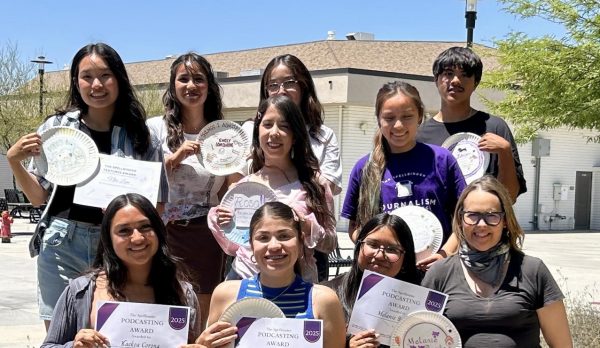Aesthetically pleasing or classism speaking?
Fashion aesthetics have become more problematic than we think.
You’re scrolling through TikTok and notice all of these fashion videos popping up on your “for you” page. The people in these videos follow different fashion aesthetics and show off their stylish outfits to thousands of viewers. However, these fashion videos contain clothing that for many is not affordable and models who only look like a select group of people.
Fashion aesthetics have been around for a while now, but their popularity skyrocketed during quarantine. Along with teenagers being stuck at home, individuals became glued to their phones with many posting pictures and videos of themselves in their outfits. Their clothes would then be categorized into an aesthetic group depending on what it looked like. At first, this was harmless and no one thought much of it, but problems become apparent with more knowledge of the situation.
People may feel as if they can’t partake in any fashion aesthetics because they can’t afford it. The faces of many aesthetics promote expensive clothing and accessories that aren’t inclusive of other people. This issue of not including individuals who can’t pay for these high-priced items is an act of classism. Classism has been a problem in the United States since it became an independent country.
Junior Daisy Barragan said, “I feel like classism is definitely attitude based and it’s definitely something that is deeply integrated into our society.”
This class issue can be seen in many different shapes and forms. It’s not all just wealthy people making fun of those who are less fortunate, it’s people excluding those who aren’t as well off as them and claiming they’re better. When it comes to fashion aesthetics, classism arises when the clothes or accessories of certain aesthetics have to be from a specific brand.
An example of this is seen in the VSCO girl aesthetic. These people are known for wearing oversized T-shirts, messy buns, accessorizing with scrunchies, and carrying around a Hydro Flask. These water bottles are easily over thirty dollars however, the price doesn’t stop at just Hydro Flasks. The Fjallraven Kanken Mini backpack is also a big aspect of this aesthetic, and they’re not cheap. These small backpacks are eighty dollars and with just the water bottle and backpack, you’ve already spent over one hundred dollars. Not everyone has this money to spend and this can lead people to feel unwelcome to the VSCO girl aesthetic.
The much controversial clean girl aesthetic emerged early last year and was made popular by skinny white women. This look rocks slicked-back hair, gold hoops, and clean well put together outfits. While the outfits themselves may not be too flashy, the products involved in this aesthetic encourage people to spend a lot of money on jewelry and high-end clothes.
However, that’s not the only problem with this aesthetic; the creators of it were actually Black and Latina women. During the 90s and 2000s, these women wanted to create their own style so they began to slick back their hair and wear gold hoops. The look was then recently rebranded for white women and named the clean girl aesthetic.
Old money aesthetic is another harmful aesthetic that emphasizes classism. As the name suggests, this aesthetic encourages people to dress as if they had millions of dollars and wear designer clothes and accessories like it’s nothing. Of course, people who are fond of this aesthetic aren’t forced to buy luxury items to be a part of this fashion group, but many of them who don’t have the money to spend feel left out as a result.
Julie Rasmussen, who owns her own boutique called Good JuJu Lifestyle Boutique said, “Classism is an old energy that weighs down the evolution of mankind.”
The reason why we follow fashion aesthetics is because we ultimately want to fit in. We want to look like the famous people we love and admire and the easiest way we can do this is by dressing like them.
MCHS counselor Janet Montes said, “There’s this misconception that if you wear certain things it means that you’re of a certain kind of people or you have a certain amount of money.”
However, there are other reasons why we dress the way we do. People may follow certain fashion aesthetics because they simply resonate with them. They feel a connection to the clothes they wear and link their personality to their apparel.
Barragan said, “It just makes us feel more comfortable. For example, the whole aesthetic of VSCO girl, there was a personality tied to it, and political affiliations like a lot of environmental subjects.”
Furthermore, most people don’t follow just one aesthetic. Yet, this is something we don’t really see in the media due to the hyperfixation of only following one aesthetic and sticking to just that one. It’s not a bad thing to follow fashion aesthetics, but people who don’t fit into one aesthetic shouldn’t feel bad about embracing others. Fashion aesthetics create these unnecessary categories where people don’t feel like they have as much freedom to dress how they want.
“I feel like the need for categorizing everything is a bit too over excessive, and I feel like that’s ruining a bit of the whole aesthetic thing,” Barragan said.
On top of that, fashion aesthetics are inherently fatphobic. It’s extremely rare to see a plus-sized person displaying any of these aesthetics in the media. There are influencers that post themselves wearing their trendy outfits but it doesn’t change the fact that many aren’t embraced by fashion aesthetics in the first place. This issue stems from the fashion industry’s history of fatphobia. More and more plus-sized models are emerging, but in order for everyone to feel seen, more has to be done.
On the other hand, fashion aesthetics aren’t only negative. They allow people to express themselves and form a sense of community with the people who dress like them. Our clothes allow us to show the world who we are without having to say anything. We can embrace what makes us unique by wearing the clothes of our choosing. No one should feel as if they can’t be a part of a certain fashion aesthetic because they can’t afford the clothing that’s usually associated with it. At the end of the day, people are going to wear what they want, whenever they want.
Rasmussen said, “Be free in spirit and remember you are the creator of your reality.”

My favorite color is purple, I’ve been dancing since I was 5, and I love to read.





































